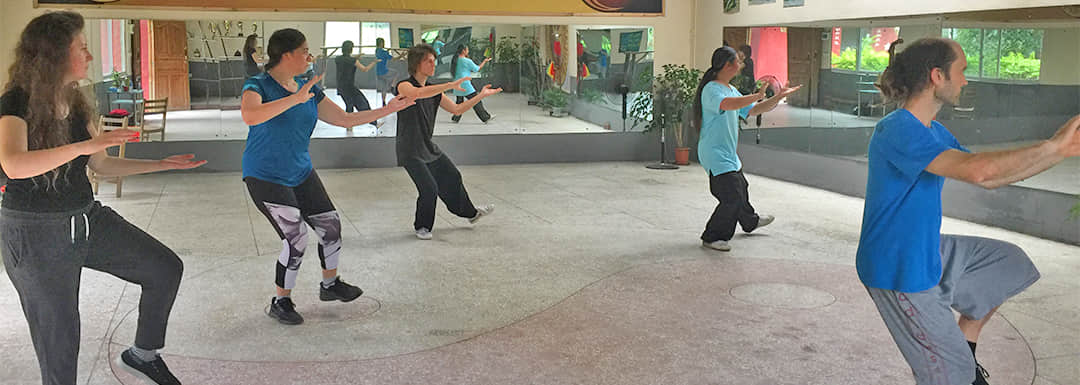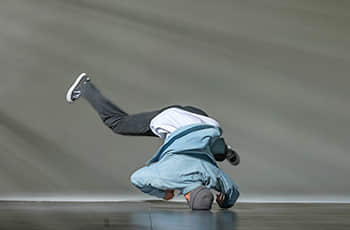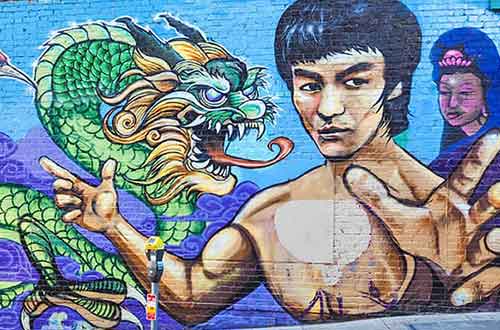Kung Fu in Western Society

The endurance and perseverance of Chinese martial arts over time has been astounding: for over 2000 years, martial arts such as Kung Fu have been again and again associated with eminence and social prestige in China. It may come as a surprise, then, that the cultural exchanges between China and the West only really materialized in the last century.
Indeed, for most of history, the relations between both regions were limited to rather sporadic instances of exchange that took place mostly through individuals. What really propelled Chinese martial arts or Kung Fu the Western cultural imagery was, instead, the explosion of pop culture that took place during the 60s and 70s, through movies, literature and even music (hip hop). How can this shift be explained?
Kung Fu in Chinese/Wester relations: an overview
The reason for this sudden development is multifaceted as well as entangled with the broader political context which shaped the cultural relationship between China and the West. On the one hand, China had for centuries shown a propensity for cultural isolation, which was reflected in the advocacy of isolationist policies in its dealing with foreign affairs. By contrast, the Western model of both international relations and economics was aggressive and belligerent; beyond the projected value of trade and potential economic exploitation, there was little if any interest in Chinese society and its way of life. Hence, the idea of China that existed in the Western imagination was shaped by the few merchants, missionaries and adventurers who had dared to tread on the silk routes that led to distant China and who came back with astonishing tales of the great and rich empire of the East.
This was for instance the case of the Venetian merchant, Marco Polo, who spent more than twenty years in China during the Yuan Dynasty (1271-1368) and became famous because of his writing of a book, Book of the Marvels of the World which recorded his travels. This scarce contact meant that Kung Fu never reached Western shores. But this was no accident. As Western powers followed by Japan deployed their policies of economic and cultural imperialism onto Chinese land in the last two hundred years, Kung Fu masters swore to an unwritten consensus to not divulge the skill to non-Chinese individuals, a consensus which perdured well into the 20th century (for instance Bruce Lee, after opening his school to the non-Chinese, was harshly criticized by the Kung-Fu community).
Kung Fu, with its merging of combat martial art with distinct elements of Chinese philosophy, was meant to be a well-preserved secret which could, arguably, provide an efficient weapon and identity to counter Western and Japanese hegemony. This point hints at why many of the most well-known Kung Fu movies are set in the times of Japanese invasion. Later in the 20th century, Kung Fu -through art and popular fiction -- became for the first time a medium that served to showcase Chinese identity and culture to the rest of the world. And it was precisely in these domains - and fore mostly in cinema-, that Kung Fu carved a name for itself and left an everlasting impact in the Western society.
Why is Chinese Kungfu popular in Western Society today?
The ascent towards fame of the remarkable martial art master and actor, Bruce Lee’s ascent to fame was without doubt, a key development that led to the popularity of Kung Fu in the West.
Bruce Lee and Western cinema


While Kung Fu had already been featured in Hong Kong cinema since the1940s, the practice did not hold the attention of the Western public, which instead showed a greater interest in the Japanese martial arts of Karate and Judo. This was in part because of closer ties between Japan and the West, the export of Japanese cinema was substantially larger than its Chinese counterpart. This tendency, in turn, was inverted with the rise of Bruce Lee in Hong Kong and Hollywood cinematic productions.
The practice became eminently popular in Chinese cultural artworks: the number of chuanqi (legendary tales) in Wuxia novels and theatrical plays featuring Kung Fu scenography and storylines exploded, even though those who actually practiced it were typically involved with the military in a way or another. The most distinguished military warriors were often simultaneously the most remarkable Kung Fu masters, and pioneers of new forms and styles.
The reason for his success was manifold. While on the one hand, his fanatical working ethic and unparalleled charisma served him well, the forces that enabled his success to take dumfounding proportions were historical.
Indeed, a dramatic shift in the sensibilities of the Western population, which took place through the post-war baby-boom generation and rebelled against dominant cultural narratives, colonialism and fought for minority as well as human rights, facilitated the ascent and almost foretold the imminent popularity of Bruce Lee’s character.
The fact that he embodied a charismatic hero from a disadvantaged social and cultural reality and yet who at the same time fought for the same ideals and virtues that were in vogue at the time, provided an immense source of identification for the Western public who saw him as a hero they could praise and glorify.
Bruce Lee typically appeared in cinema performing ordinary yet also highly moral characters which saw found themselves entrenched in the grim reality of subordination, exploitation and injustice. Just as Lee had struggled personally against prejudices and discriminatory treatment he faced in the U.S., the characters instrumentalize Kung Fu as a tool to physically and symbolically wrestle against oppression and injustice.
In other words, Kung Fu was introduced to international audiences as a practice which could empower the self against social hierarchies and the grinding complexities of modern life. A striking example of this is the influence this message had on the hip hop movement.
Hip-pop

As Bruce Lee was leading the way and introducing Kung Fu to cinema enthusiasts - at the speed of 24 frames a second-, at the same time period, among the black youth the Bronx, New York, a new movement was growing: hip-hop. Gradually, early hip hop became a Kung Fu-inspired type of music that channelled the voice of the alienated and disempowered post-industrial urban minority youth around the United States. The influence of Kung Fu can be felt, for instance, in the visual aesthetic of hip-hop choreographies, and specifically their dance of distinctive improvised moves called breakdance.
Breakdance quickly led to the emergence of dance battles, in which opposing sides would compete with one another, and attempt to demonstrate superior skill, creativity, elasticity, etc. In many regards, these dance battles in part emulate famous fighting scenes in Kung Fu films. Wu Tang Clan, one of the most distinguished hip hop groups, for instance based their name after a Hong Kong film called Shaolin vs Wu Tang. Their debut album name Enter the Wu Tang (36 Chambers) is another clear indicator of the extent to which the Chinese martial art has impacted the hip-hop movement.
In an interview, RZA, a Wu Tang Clan member, avowed the following:
“We would watch them [Kung Fu films] every weekend. That was around the age of nine. By the time I was twelve or thirteen I started getting fascinated. I would go into Chinatown buying everything. Kung Fu books, slippers. You name it, I was on a mission.”
Bruce Lee’s premature death, in 1973, intensified the Kung Fu phenomenon in the West, and his work was the source of inspiration for countless directors and actors which from then onwards sought to render homage to Lee by means of scenarios which featured Kung Fu masters and actors.
The television series Kung Fu, starring David Carradine in the role of the Shaolin monk in the American Old West, here comes to mind, as well as actors such as Jackie Chan, Jet Li, Donnie Yen, etc. This impact was moreover felt in a shift in the convention adopted in Hollywood action films, as many film directors saw themselves profoundly influenced by the early cinematic productions which had featured Kung Fu. For instance, both Kill Bill (2003), The Matrix film series (1999), Hollywood producers pay a special homage to Chinese martial arts through the choreographic moves adopted in fighting scenes.
Furthermore, the animated film Kung Fu Panda (2008) exemplifies the ongoing relevance and persistence of Kung Fu in the Western imaginary, and the way in which the martial art survives through different aesthetic and creative forms. The fact that Jason Statham -an actor who is proficient in the Wing Chun style of Kung Fu- is deemed the most popular action film star of the past decade in the West is also quite telling.
A Spiritual Shift?
The protracted popularity of Kung Fu has facilitated the spreading and accessibility of Chinese culture in the West.
In the context of a surge of New Wave spirituality movements seeking to comprehend and deal with the transformations taking place in Western societies, many turned to the well-kept wisdom of traditional Chinese philosophical systems.
Today, China is recognized as global economic, technological and military power which poses a real threat to the long-lasting hegemony of the West. While in terms of soft power, China’s global reach is still lagging that of the West, this gap is narrowing by the second.
The early beginnings and ascent of Chinese soft power should always be associated with Kung Fu, which played a critical role in this development, by virtue of its appeal to the rest of the world.
OR
Are you eager to begin your Chinese cultural journey?
Drop us a line and we will promptly connect you with our leading China expert!
 Dumplings and Westem World
Dumplings and Westem World  Education: China vs Western
Education: China vs Western  Chinese Tea in Western Countries
Chinese Tea in Western Countries  Shaolin Kung Fu Films
Shaolin Kung Fu Films